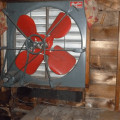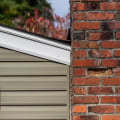This model is easy to install. It is best suited for use with tile roofs and comes with the right flanges to keep water out. The 537 CFM fan is capable of moving a lot of air through an average-sized attic (approximately 1,200 square feet), which is slightly more than the typical air conditioner. This gable mount attic fan features a rugged galvanized housing and a 3.1A motor that provides ventilation for up to 1,600 square feet of attic space.
It also comes with a built-in thermostat that you can set to automatically turn the fan on and off when the air reaches a certain temperature. For a value-conscious buyer, this fan provides plenty of flow for their money. Natural Light's solar attic fan may cost more than the other fans on this list, but it comes with some major chops. This attic fan is installed on a tile roof and uses the 36 watt solar panel to extract its energy from the sun.
This Natural Light model is capable of moving more than 1,881 cubic feet of air, an impressive feat for a solar panel powered fan. In addition to the airflow, there are some features that make this model stand out from the crowd. Unlike other solar models, this one comes with a controllable thermostat, so it doesn't work automatically just because the sun rises. This will dramatically increase the life of the fan.
You can also upgrade it by purchasing a separate 120V adapter, which will allow the fan to run at night, useful in scorching weather. The QuietCool CL-3100 is a model that eliminates the known drawbacks of older fans in the whole house. This model uses a sound-insulated duct to keep noise to a minimum while still moving a lot of air, 3.126 CFM to be exact, enough to draw fresh air through an average-sized home. When you mount a fan in the corner of your gable, you need it to be powerful enough to draw air out of the attic to work properly.
This Cool Attic CX1500 model does just that. It has a built-in adjustable thermostat that, when activated, turns on your 1,300 CFM fan, cooling attics up to 1,850 square feet quickly. If you have a partially finished attic, but still want help controlling excessive heat, this AIRTITAN T7 Infinity AC fan may be right for you. This model is small enough to fit over an air conditioning and heating vent, but can also be vented outside, operating at a programmed temperature range.
It only moves 240 cubic feet of air per minute, but it's suitable for smaller spaces in your home. The right attic fan for you depends mainly on the size of your space and the type of fan you are looking for. One of the best solar-powered attic fans available is the Broan Surface attic fan, which comes with a 28-watt solar panel, built-in waterproof flanges, and enough power to ventilate a 1,200 square foot space with its 537 CFM. This choice definitely can't compete with an air conditioning system, but it's more suitable for smaller attics or low-rise spaces.
Alternatively, if you're looking for a gable mounted fan, the iLiving attic fan has a rugged galvanized steel construction, a 1,220 CFM rating that can ventilate a 1,600 square foot space, and a programmable thermostat for attics and larger spaces. Square feet and square feet covered are also important when choosing an attic fan, as the above options are made for small or large spaces with ratings from 537 to 3,126 CFM. Finally, most of these picks work with quiet or very quiet noise levels, so you'll hardly know they're there. A solar-powered fan moves air without turning on a switch or changing batteries.
The Remington Solar 30 Watt Attic Fan is a standalone unit with a solar panel mounted directly on top of the fan. Instead of a dedicated remote control that you can find with other fans, this model uses a smartphone app to adjust its functions and programming. With this application, you can monitor both the current humidity level and the temperature of your attic at any time, as well as configure and change seasonal presets. The detailed instructions will guide you through every step of pairing your phone with the fan, a valuable feature for those who need a little more help in the technology department.
We also appreciate this fan's fire safety shutoff mechanism, which automatically shuts down the unit if it detects attic temperatures above 182 degrees Fahrenheit. While appropriate for use in an attic, this fan is also versatile enough to be used in other areas, such as a workshop, shed, or garage. Its 10-inch blade size may be smaller than most of the other fans on this list, but it still offers an impressive number of features, including the intuitive intelligent controller that allows you to adjust speed, alarms and timers during operation. It's also nice and durable, thanks to its galvanized steel shutters, aluminum impeller and an IP44 rating, ensuring it can withstand splashes of water from any direction.
This fan comes fully pre-assembled, and if you already have a gable cutout from a previous attic fan, it could be a great option for users who want to minimize installation hassle. At just 11.13 pounds, it's also light enough for a person to maneuver in place if you end up riding it yourself. A 14-inch blade and 1300 CFM output allow this unit to be used in attics up to 1,850 square feet. However, it only has one speed, so keep that in mind if you're looking for a fan with a little more functionality.
Much like attic fans, most homes have bathroom exhaust fans that also help wick away moisture and increase ventilation. This thermostat turns on the attic fan when the temperature reaches a target temperature, which is generally in the range of 90°F to 110°F. Other gable attic fans will require some simple electrical work, such as connecting wiring with cable nuts. If you have access to the pediments of your attic, the iLiving attic fan with gable mount is an excellent option for moving a little air without drilling a hole in the ceiling.
Gable attic fans are connected to the home electrical system, plugged into a standard 120-volt outlet, or run on solar energy. The benefit of a solar-powered attic fan is that it works without additional electricity, or you have to turn it on. There are a couple of different fan styles that homeowners can use to help control the temperature of the attic space. In addition to the thermostat and thermostat for automatic control, most homeowners have a physical wall switch that allows you to turn off the attic fan for any reason.
Installing the Natural Light solar attic fan may qualify you for a solar tax credit and can reduce heat buildup in your attic, saving you money on your energy costs. This fan doesn't have any insulated doors that close when not in use, so warm air may enter the attic when you don't want it. To remedy this, you can build a box or sides around the fan to make sure that air flows to the ceiling and doesn't trap insulation in the fan airflow. In addition to thermostats, some gable attic fans come with thermostats, which are sensors that sense humidity rather than temperature.
A high-quality attic fan helps regulate temperature and humidity levels while maintaining proper ventilation. The QuietCool fan starts at a fan speed of 3000 cfm and then drops to 1000 cfm automatically as the temperature drops. If you already have an attic fan that you are upgrading or replacing, you may not have to do much installation, which should reduce the overall cost of the project and could allow you to pay for a more expensive system. Dual fans are also quiet, so they are barely noticeable when the fan fights against the attic temperature.
. .



